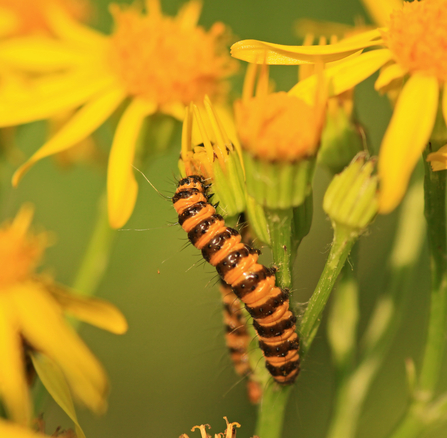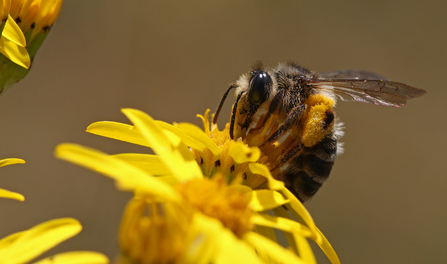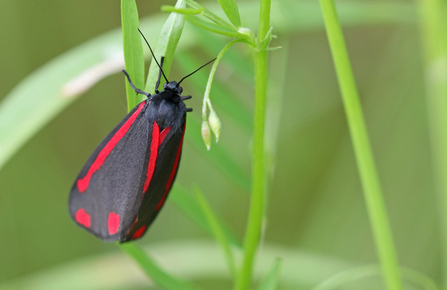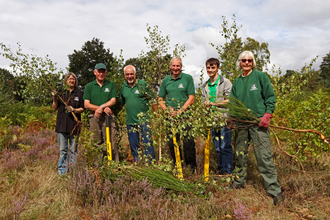Ragwort is a bit like Marmite (other yeast extract spreads are available) - you either love it or you hate it. I fall into the former category but I understand the reasons why others might not be so keen. There are 19 species of ragwort (including groundsels) in the UK, from the common to the rare and with an occasional introduced species in the mix for good measure. Exploring the differences between each species is a blog for another day but I do want to explore why it's a great plant for wildlife as well as why ragwort can be a problem that sometimes needs controlling , perhaps with some myth-busting along the way.
Golden rays
Ragwort by Wendy Carter

Cinnabar moth caterpillar by Wendy Carter
Whilst some species are smaller, common ragwort grows to about 90cm tall and is a common sight in fields, on railway embankments and can even pop up in gardens. A little like dandelions, their bright yellow flowers brighten up Worcestershire's landscape. The flowers produce nectar for many pollinating insects to feed on whilst the plants themselves are food for other insects; it is the only foodplant for the caterpillars of cinnabar moths, for example, and 30 species of insect rely on ragwort as their only source of food.
Ragwort is a pioneer plant that can grow in abundance. The seeds need bare ground in order to germinate and the plants have hundreds, if not thousands, of seeds. Studies have shown, however, that less than 1% become airborne, with most falling within 40m of the parent plant (Harper & Wood, 1957). So, whilst the seed can and does spread, albeit most of it doesn't go far, the bigger problem is the potential inclusion of the plant in animal feed.
Ragworts contain toxins (pyrrolizidine alkaloids) and owners of horses and other livestock are rightly concerned about this. The good news is that the plant tastes bitter so is ignored when its growing. I've seen many fields and paddocks that are grazed to the ground but the horses still haven't touched the ragwort. If field is to be cut for hay, however, it's vital that ragwort has been removed from the field to be cut. Whilst animals will ignore ragwort growing in their field it's a different matter if it's dried and in their hay. The effect of the toxins is cumulative, building up as an animal continues to eat hay with ragwort included until a fatality inevitably occurs.

Grey-banded mining bee by Wendy Carter
The law recognises that ragwort is a native plant and that many species of wildlife depends on it, proposing its strategic removal in areas where it poses a threat to the health and welfare of grazing animals and the production of feed or forage. With 41% of insect species at risk of extinction in the UK, it's crucial that we manage ragwort for the benefit of both insects and livestock - leaving it where we can and removing it where we need to. There's one more way of helping wildlife if we do need to remove ragwort - rehome the wildlife.
On our nature reserves, our volunteers do a fabulous (but back-breaking job) of pulling ragwort in fields that are to be cut for hay. Once a field of wildflowers has been mown, removing the cuttings (and following this with grazing) is essential to allow wildflowers to compete and thrive against more aggressive grasses. At our Dropping Well Farm nature reserve near Bewdley, taking a hay cut also helps to reduce the nutrients in the soil - an important part of our ambition to restore heathland here.
In two of the fields at Dropping Well Farm this year, our Saving Worcestershire's Heathlands colleague Joe is taking some college students and schoolchildren there before the pulling begins. Armed with boxes, Joe's plan is for the eagle-eyed youngsters to spot and rehome any cinnabar caterpillars. Ragwort grows in abundance on verges and roadsides in this part of Worcestershire so the caterpillars will be gently lifted from the ragwort before our hay is taken and rehomed to places where the ragwort isn't removed. This will also act as a sustainable natural control, knocking back ragwort growth elsewhere whilst fostering the next generation of beautiful cinnabar moths - a win-win for nature and for people.

Cinnabar moth by Wendy Carter




